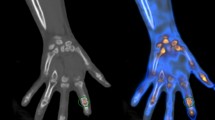Abstract
The objective of this study was to assess qualitative and quantitative patterns of tracer accumulation to increase the diagnostic utility of bone scintigraphy in reflex sympathetic dystrophy (RSD). Of 120 patients with high clinical suspicion for RSD, 96 were confirmed as having RSD during follow-up, while the remaining 24 were used as controls. Clinical parameters were measured and correlated to five activity ratios (0–30 s, 0.5–5 min, 5–15 min, 3 h, 24 h) and five scintigraphic signs. Monitoring three dynamic phases revealed different tracer kinetics of potential diagnostic utility; however, the 24-h bone phase offered no additional diagnostic contribution and can be omitted. Quantification provided objective parameters for the duration of symptoms, pain and impairment of movement but not for surface temperature differences, swelling and impairment of physical force. It is of limited use for diagnosis except for the exclusion of disease. Discriminant analysis revealed the combination of three signs (diffuse uptake in carpus/tarsus+diffuse uptake in all small joints+increased activity ratio in the late blood pool phase) to be the pattern with the highest diagnostic accuracy independent of localisation, sex, age and precipitating factors. It is concluded that the scintigraphic confirmation of RSD is based on lateralisation in the late blood pool phase and the described pattern in the early bone phase.
Similar content being viewed by others
References
Roberts WJ. A hypothesis on the physiological basis for causalgia and related pains. Pain 1986; 24: 297–311.
Genant HD, Kozin F, Bekerman C, McCarthy DJ, Sims J. The reflex sympathetic dystrophy syndrome: a comprehensive analysis using fine detail radiography, photon absorptiometry and bone and joint scintigraphy.Radiology 1975; 117: 21–23.
Sambrook P, Champion GD. Reflex sympathetic dystrophy: characteristic changes in bone on CT Scan.J Rheumatol 1990; 17: 10–11.
Koch ES, Hofer HO, Sealer G, Marincek B, Schulthess GKV. Failure of MR imaging to detect reflex sympathetic dystrophy of the extremities.Am J Roentgenol 1991; 156: 113–115.
Moesker A, Boersma FP, Schijgrond HW, Cortvriendt W. Treatment of posttraumatic sympathetic dystrophy (Sudeck's atrophy) with guanethidine and ketanserin.The Pain Clinic 1985; 1: 171–176.
Bekerman C, Genant HK, Hofer PB, et al. Radionuclide imaging of the bones and joints of the hand.Radiology 1976; 118: 653.
Kozin F, Genant HK, Bekerman C, McCarty DJ. The reflex sympathetic dystrophy syndrome. II. Roentgenographic and scintigraphic evidence of bilaterality and of periarticular accentuation.Am J Med 1976; 60: 332–338.
Simon H, Carlson DH. The use of bone scanning in the diagnosis of reflex sympathetic dystrophy.Clin Nucl Med 1980; 3: 116–121.
Kotzin F, Soin JS, Ryan LM, Carrera GF, Wortmann RL. Bone scintigraphy in the reflex sympathetic dystrophy syndrome.Radiology 1981; 138: 437–443.
Intenzo C, Kim S, Millin J, Park C. Scintigraphic patterns of the reflex sympathetic dystrophy syndrome of the lower extremities.Clin Nucl Med 1989; 106: 437–440.
Greyson ND, Tepperman PS. Three-phase bone studies in hemiplegia with reflex sympathetic dystrophy and the effect of disuse.J Nucl Med 1984; 25: 423–429.
Holder LE, Mackinnon SE. Reflex sympathetic dystrophy in the hands: clinical and scintigraphic criteria.Radiology 1984; 152: 517–522.
Kozin F, Rayan LM, Carerra GF, Soin JS, Wortmann RL. The reflex sympathetic dystrophy syndrome (RSDS). III. Scintigraphic studies, further evidence for the therapeutic efficacy of systemic corticosteroids and proposed diagnostic criteria.Am J Med 1981; 70: 23–30.
Demangeat JL, Constantinesco A, Bruno B, Foucher G, Farcot JM. Three-phase bone scanning in reflex sympathetic dystrophy of the hand.J Nucl Med 1988; 29: 26–32.
Willame LMA, Scand A. Hypofixation on bone scintigraphy in reflex sympathetic dystrophy syndrome.Clin Rheumatol 1991; 10: 73–75.
Kline SC, Holder LE. Segmental reflex sympathetic dystrophy: clinical and scintigraphic criteria.J Hand Surg [Am] 1993; 18: 853–859.
Koppers B. Drei-Phasen-Szintigraphie beim Sudeck-Syndrom. Vergleich mit radiologischen und klinischen Untersuchungsergebnissen.Fortschr Röntgenstr 1982; 137: 564–579.
Davidoff G, Werner R, Cremer S, Jackson D, Ventocella C, Wolf L. Predictive value of the three-phase technetium bone scan in diagnosis of reflex sympathetic dystrophy syndrome.Arch Phys Med Rehabil 1989; 70: 135–137.
Carlson DH, Simon H, Wegner W. Bone scanning and diagnosis of reflex sympathetic dystrophy secondary to herniated lumbar disks.Neurology 1977; 27: 791–793.
Prakash V, Kamel NJ, Lin MS. Increased skeletal localization of99mTc-diphosphonate in paralyzed limbs.Clin Nucl Med 1976; 1: 48–50.
Tepperman PS, Greyson ND, Hilbert L, et al. Reflex sympathetic dystrophy in hemiplegia.Arch Phys Med Rehabil 1984; 65: 442–447.
Schurawitzki H, Wickenhauser J, Fezoulidis I, Sadil V, Fialka V, Das Sudeck Syndrom — eine kombinierte klinischröntgenologisch-nuklearmedizinische Studie.Unfallchirurgie 1988; 14: 238–246.
O'Mara RE. Benign bone disease. In: Gottschalk A, Hoffer PB, Potchen EJ, eds. Diagnostic nuclear medicine, 2nd edn. Baltimore: Williams & Wilkins; 1988: 1033–1075.
Holder LE, Cole LA, Myerson MS. Reflex sympathetic dystrophy in the foot: clinical and scintigraphic criteria.Radiology 1992: 184: 531–535.
Atkins RM, Tindale W, Bickerstaff D, Kanis JA. Quantitative bone scintigraphy in reflex sympathetic dystrophy.Br J Rheumatol 1993; 32: 41–45.
Fialka V, Zifko I, Schneider B, Schurawitzki H. Long-term studies on reflex sympathetic dystrophy.Eur J Phys Med Rehabil 1992; 2: 58–62.
Author information
Authors and Affiliations
Rights and permissions
About this article
Cite this article
Leitha, T., Staudenherz, A., Korpan, M. et al. Pattern recognition in five-phase bone scintigraphy: diagnostic patterns of reflex sympathetic dystrophy in adults. Eur J Nucl Med 23, 256–262 (1996). https://doi.org/10.1007/BF00837623
Received:
Revised:
Issue Date:
DOI: https://doi.org/10.1007/BF00837623




